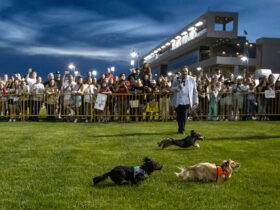Workspaces are evolving to incorporate changes that will last a lifetime. Here are some of the unfolding office design trends to expect in 2022 and beyond.
Facing numerous obstacles in the past two years, including a worldwide pandemic, organizations have been forced to pivot and rethink how teams work. As a result, the office layout is evolving and incorporating changes that will last a lifetime.
Mask mandates, illness, hand sanitizing and social distancing have driven numerous shifts in the workspace. As a result, offices have begun utilizing plexiglass dividers on desks, distancing desks and regulating the amount of people allowed in rooms at a time. However, other changes – such as outdoor workspaces – may require more long-term changes to how we envision workspaces.
We recently spoke with some local architects to better understand some of the changes they’re seeing ‘on the ground’ when it comes to office design and layouts. The following are some of the top trends they’ve identified, which will impact workspaces in 2022 and beyond.

Maintaining both remote and in-person working
Prior to the COVID-19 pandemic, many companies didn’t think about incorporating remote work options. In a troubling twist, remote work soon become the sole option for keeping most businesses running during the pandemic.
“Businesses are quickly breaking free of some of the old forms of the traditional office space because they’ve learned they have to if they want to survive,” said Anthony Guzzo, Principal of Guzzo Architects.
Businesses are rearranging the workplace to have features that can accommodate both remote and in-person work needs. As companies begin to open back up, some individuals feel more comfortable about returning to work than others. Preferences will vary so it is best to continue providing options to the employees. This way, they can balance the comfort of remote working and the joys of in-person working.
“The Blue Foundry Bank Corporate Headquarters we designed is the perfect example of an office that balances prioritizing in-person work and efficiently supporting the realistic demands of remote work,” said Lloyd Rosenberg, President & CEO of DMR Architects.

Construction for the Blue Foundry Bank Corporate Headquarters was planned to place at the peak of the COVID-19 pandemic and DMR Architects followed through. The team helped to create a safe space for employees to be excited about returning to. The space was designed to support hybrid work in order to keep employees comfortable, excited and safe all at the same time.
“This meant creating a progressive design statement we have not previously seen with elements such as benching systems, sit/stand desks, lounges with fire features, a cafeteria with beer, wine and kombucha taps, spaces dedicated for flexible collaboration and the integration of software for a non-reserved seating system,” said Rosenberg.
Making sanitation part of office design
Offices have been changing rapidly to incorporate more efficient means of sanitation practices. Examples include adding sinks in break rooms and offering hand sanitizer dispensers in more areas of the office. The concept of implementing sanitation will need to remain in place so that employers and employees can do their part in terminating the COVID-19 pandemic.
Leaning toward unassigned seating
Unassigned seating is often used in circumstances where there are less people in the workspace because intensive organization isn’t super necessary for small groups.
“Hot desking seems to be a luxury that is a result of fewer people in the office,” said Anthony Iovino, Principal at Arcari + Iovino Architects.
Here’s another perk to hot desking. Although we would typically assume assigned seating would be the more sanitary option, it’s not. Assigned seating requires that employees choose whatever communal space they want to sit at, so they are unable to claim a permanent desk and keep their belongings there. This means that the cleaning staff is able to deep clean the spaces without having to avoid certain desks that hold personal belongings on them.
Another part of this change is to split the communal spaces with dividers and social distance markers so that employees can maintain distance, keeping themselves and each other safe.
Along with offering a safe distance, employees are able to float around to new spaces. This can help get their creative thinking flowing and their minds in a more focused state.
 Embedding new technology into the office
Embedding new technology into the office
Many businesses are utilizing more technology driven features to maintain the safety of their staff and clients. This includes new touchless check-in solutions and QR code solutions. The new touchless technological facets limit touchpoints which, in turn, limit the spread of COVID-19.
“Designing Blue Foundry Bank’s headquarters completely wirelessly enabled many important functions of their office to come to life, including their hybrid model, non-reserved seating system and casual spaces that allow for spontaneous collaboration,” said Rosenberg
Increasing good air quality and circulation
To suppress the spread of COVID-19 in the workspace, companies need to ensure they are using materials that allow for good air quality.
“Improvements to HVAC systems including better air filtration and the use of bipolar ionization are typical focus points for improving the quality of indoor air,” said Iovino.
Some companies have even turned to decorating their spaces with plants and greenery to help boost the air quality as well as give the employees a sense of nature when they’re stuck working inside. This is a simple, yet effective way to “kill two birds with one stone,” making the employees happy and keeping the environment healthier at the same time.
The future of our workspaces
Our workspaces have endured unexpected changes over the span of the COVID-19 pandemic – and there’s no going back. The shifts in design provide safer ways for employees to return to some notion of normalcy. Unfortunately, our offices won’t be going back to pre-pandemic normal. But, fortunately, our offices will be safer for us to work in under new circumstances.
No one expected a worldwide spread of a virus so not being prepared in the initial stages of the mayhem made it hard to put a plan in place. Now, we have a plan so our work environments can withstand the winds – and we are better prepared for whatever comes next.










